Comparison of Intestinal Microbiota of Blue Fox before and after Weaning
Abstract
Simple Summary
Abstract
1. Introduction
2. Materials and Methods
2.1. The Management of the Blue Foxes and Sample Collection
2.2. DNA Extraction and Polymerase Chain Reaction (PCR) Amplification
2.3. Illumina MiSeq Sequencing
2.4. Processing of Sequencing Data
2.5. Statistical Analysis
3. Results
3.1. Evaluation of Sample Sequencing
3.2. Difference of Intestinal Flora of Blue Fox before and after Weaning
3.2.1. Sample Diversity Analysis
3.2.2. Venn Diagram Analysis Based on Operational Taxonomic Units
3.2.3. Multi-Sample Comparative Analysis
3.2.4. Structural Analysis of Intestinal Microbiota
3.2.5. LEfSe Species Difference Analysis
3.3. Analysis of Bacterial Flora Structure Difference between Fecal and Intestinal Contents
3.3.1. Sample Diversity Analysis of Fecal and Intestinal Contents
3.3.2. Venn Diagram Analysis Based on Operational Taxonomic Units
3.3.3. Multi-Sample Comparative Analysis
3.3.4. UPGMA Cluster Analysis
3.3.5. Significance Test of Differences in Community Structure of Feces and Various Intestinal Contents
3.3.6. LEfSe Species Difference Analysis
4. Discussion
5. Conclusions
Author Contributions
Funding
Institutional Review Board Statement
Informed Consent Statement
Data Availability Statement
Acknowledgments
Conflicts of Interest
References
- Wu, L.T.; Tang, Z.R.; Chen, H.Y.; Ren, Z.X.; Ding, Q.D.; Liang, K.Y.; Sun, Z.H. Mutual interaction between gut microbiota and protein/amino acid metabolism for host mucosal immunity and health. Anim. Nutr. 2021, 7, 11–16. [Google Scholar] [CrossRef] [PubMed]
- Banerjee, S.; Maiti, T.K.; Roy, R.N. Enzyme producing insect gut microbes: An unexplored biotechnological aspect. Crit. Rev. Biotechnol. 2022, 42, 384–402. [Google Scholar] [CrossRef] [PubMed]
- Ramakrishna, B.S. Role of the gut microbiota in human nutrition and metabolism. J. Gastroenterol. Hepatol. 2013, 28, 9–17. [Google Scholar] [CrossRef] [PubMed]
- Baxter, N.T.; Schmidt, A.W.; Venkataraman, A.; Kim, K.S.; Waldron, C.; Schmidt, T.M. Dynamics of human gut microbiota and short-chain fatty acids in response to dietary interventions with three fermentable fibers. MBio 2019, 10, e02566. [Google Scholar] [CrossRef] [PubMed]
- Yoon, H.S.; Cho, C.H.; Yun, M.S.; Jang, S.J.; You, H.J.; Kim, J.H.; Han, D.; Cha, K.H.; Moon, S.H.; Lee, K.; et al. Akkermansia muciniphila secretes a glucagon-like peptide-1-inducing protein that improves glucose homeostasis and ameliorates metabolic disease in mice. Nat. Microbiol. 2021, 6, 563–573. [Google Scholar] [CrossRef] [PubMed]
- Deng, Z.; Luo, X.M.; Liu, J.; Wang, H. Quorum sensing, biofilm, and intestinal mucosal barrier: Involvement the role of probiotic. Front. Cell. Infect. Microbiol. 2020, 10, 538077. [Google Scholar] [CrossRef] [PubMed]
- Sanidad, K.Z.; Zeng, M.Y. Neonatal gut microbiome and immunity. Curr. Opin. Microbiol. 2020, 56, 30–37. [Google Scholar] [CrossRef] [PubMed]
- Lallès, J.P.; Bosi, P.; Smidt, H.; Stokes, C.R. Weaning-A challenge to gut physiologists. Livest. Sci. 2007, 108, 82–93. [Google Scholar] [CrossRef]
- Schloss, P.D.; Schubert, A.M.; Zackular, J.P.; Iverson, K.D.; Young, V.B.; Petrosino, J.F. Stabilization of the murine gut microbiome following weaning. Gut Microbes 2012, 3, 383–393. [Google Scholar] [CrossRef]
- Weström, B.; Arévalo Sureda, E.; Pierzynowska, K.; Pierzynowski, S.G.; Pérez-Cano, F.J. The immature gut barrier and its importance in establishing immunity in newborn mammals. Front. Immunol. 2020, 11, 1153. [Google Scholar] [CrossRef]
- Choudhury, R.; Middelkoop, A.; Boekhorst, J.; Gerrits, W.J.J.; Kemp, B.; Bolhuis, J.E.; Kleerebezem, M. Early life feeding accelerates gut microbiome maturation and suppresses acute post-weaning stress in piglets. Environ. Microbiol. 2021, 23, 7201–7213. [Google Scholar] [CrossRef] [PubMed]
- Frese, S.A.; Parker, K.; Calvert, C.C.; Mills, D.A. Diet shapes the gut microbiome of pigs during nursing and weaning. Microbiome 2015, 3, 28. [Google Scholar] [CrossRef] [PubMed]
- Tang, X.; Xiong, K.; Fang, R.; Li, M. Weaning stress and intestinal health of piglets: A review. Front. Immunol. 2022, 13, 1042778. [Google Scholar] [CrossRef] [PubMed]
- Tretola, M.; Luciano, A.; Ottoboni, M.; Baldi, A.; Pinotti, L. Influence of traditional vs alternative dietary carbohydrates sources on the large intestinal microbiota in post-weaning piglets. Animals 2019, 9, 516. [Google Scholar] [CrossRef] [PubMed]
- Liao, R.; Xie, X.; Lv, Y.; Dai, J.; Lin, Y.; Zhu, L. Ages of weaning influence the gut microbiota diversity and function in Chongming white goats. Appl. Microbiol. Biotechnol. 2021, 105, 3649–3658. [Google Scholar] [CrossRef]
- Xiong, X.; Tan, B.; Song, M.; Ji, P.; Kim, K.; Yin, Y.; Liu, Y. Nutritional intervention for the intestinal development and health of weaned pigs. Front. Vet. Sci. 2019, 6, 46. [Google Scholar] [CrossRef]
- Pyykönen, T. Environmental Factors and Reproduction in Farmed Blue Fox (Vulpes lagopus) Vixens. Ph.D. Thesis, University is Kopijyvä, Kuopio, Finland, 2008. [Google Scholar]
- Xu, Y.; Su, H.; Li, T.; LV, J.; Liu, J.Y.; Bai, X.J. Effects of fly maggot protein replacement of fish meal on growth performance, immune level, antioxidant level, and fecal flora of blue foxes at weaning stage. Animals 2022, 12, 1480. [Google Scholar] [CrossRef]
- Edgar, R.C. UPARSE: Highly accurate OTU sequences from microbial amplicon reads. Nat. Methods 2013, 10, 996. [Google Scholar] [CrossRef]
- Pruesse, E.; Quast, C.; Knittel, K.; Fuchs, B.M.; Ludwig, W.; Peplies, J.; Glöckner, F.O. SILVA: A comprehensive online resource for quality checked and aligned ribosomal RNA sequence data compatible with ARB. Nucleic Acids Res. 2007, 35, 7188–7196. [Google Scholar] [CrossRef]
- Kõljalg, U.; Larsson, K.H.; Abarenkov, K.; Nilsson, R.H.; Alexander, I.J.; Eberhardt, U.; Erland, S.; Høiland, K.; Kjøller, R.; Larsson, E.; et al. Ursing BM.UNITE: A database providing web-based methods for the molecular identification of ectomycorrhizal fungi. New Phytol. 2005, 166, 1063–1068. [Google Scholar] [CrossRef]
- Desantis, T.Z.; Hugenholtz, P.; Larsen, N.; Rojas, M.; Andersen, G.L. Greengenes, a chimera-checked 16s rrna gene database and workbench compatible with arb. Appl. Environ. Microbiol. 2006, 72, 5069–5072. [Google Scholar] [CrossRef] [PubMed]
- Schoch, C.L.; Ciufo, S.; Domrachev, M.; Hotton, C.L.; Kannan, S.; Khovanskaya, R.; Leipe, D.; Mcveigh, R.; O’Neill, K.; Robbertse, B.; et al. NCBI Taxonomy: A comprehensive update on curation, resources and tools. Database 2020, 2020, baaa062. [Google Scholar] [CrossRef] [PubMed]
- Fish, J.A.; Chai, B.; Wang, Q.; Sun, Y.; Brown, C.T.; Tiedje, J.M.; Cole, J.R. FunGene: The Functional Gene Pipeline and Repository. Front. Microbiol. 2013, 4, 291. [Google Scholar] [CrossRef] [PubMed]
- Öpik, M.; Vanatoa, A.; Vanatoa, E.; Moora, M.; Davison, J.; Kalwij, J.M.; Reier, Ü.; Zobel, M. The online database MaarjAM reveals global and ecosystemic distribution patterns in arbuscular mycorrhizal fungi (Glomeromycota). New Phytol. 2010, 188, 223–241. [Google Scholar] [CrossRef] [PubMed]
- Hall, M.; Beiko, R.G. 16S rRNA gene analysis with QIIME2. Microbiome Anal. Methods Protoc. 2018, 2018, 113–129. [Google Scholar]
- Rinninella, E.; Raoul, P.; Cintoni, M.; Franceschi, F.; Miggiano, G.A.D.; Gasbarrini, A.; Mele, M.C. What is the healthy gut microbiota composition? A changing ecosystem across age, environment, diet, and diseases. Microorganisms 2019, 7, 14. [Google Scholar] [CrossRef]
- Chen, S.S. Analysis of Gut Microbiota Diversity in Blue Fox and Comparative Study on Its Enrichment Methods In Vitro. Master’s Thesis, Chinese Academy of Agricultural Sciences, Beijing, China, 2019. [Google Scholar]
- Woting, A.; Pfeiffer, N.; Loh, G.; Klaus, S.; Blaut, M. Clostridium ramosum promotes high-fat diet-induced obesity in gnotobiotic mouse models. mBio 2014, 5, e01530-14. [Google Scholar] [CrossRef]
- De Filippo, C.; Cavalieri, D.; Di Paola, M.; Ramazzotti, M.; Poullet, J.B.; Massart, S.; Collini, S.; Pieraccini, G.; Lionetti, P. Impact of diet in shaping gut microbiota revealed by a comparative study in children from Europe and rural Africa. Proc. Natl. Acad. Sci. USA 2010, 107, 14691–14696. [Google Scholar] [CrossRef]
- Moschen, A.R.; Wieser, V.; Tilg, H. Dietary Factors:Major Regulators of the Gut’s Microbiota. Gut Liver 2012, 6, 411–416. [Google Scholar] [CrossRef]
- Mach, N.; Foury, A.; Kittelmann, S.; Reigner, F.; Moroldo, M.; Ballester, M.; Esquerré, D.; Rivière, J.; Sallé, G.; Gérard, G.; et al. The effects of weaning methods on gut microbiota composition and horse physiology. Front. Physiol. 2017, 8, 535. [Google Scholar] [CrossRef]
- Fusco, V.; Quero, G.M.; Cho, G.S.; Kabisch, J.; Meske, D.; Neve, H.; Bockelmann, W.; Franz, C.M. The genus Weissella: Taxonomy, ecology and biotechnological potential. Front. Microbiol. 2015, 6, 155. [Google Scholar] [CrossRef] [PubMed]
- Iwao, M.; Gotoh, K.; Arakawa, M.; Endo, M.; Honda, K.; Seike, M.; Murakami, K.; Shibata, H. Supplementation of branched-chain amino acids decreases fat accumulation in the liver through intestinal microbiota-mediated production of acetic acid. Sci. Rep. 2020, 10, 18768. [Google Scholar] [CrossRef] [PubMed]
- Teixeira, C.G.; Fusieger, A.; Milião, G.L.; Martins, E.; Drider, D.; Nero, L.A.; de Carvalho, A.F. Weissella: An emerging bacterium with promising health benefits. Probiotics Antimicrob. Proteins 2021, 13, 915–925. [Google Scholar] [CrossRef] [PubMed]
- Kim, H.B.; Isaacson, R.E.J.V.M. The pig gut microbial diversity: Understanding the pig gut microbial ecology through the next generation high throughput sequencing. Vet. Microbiol. 2015, 177, 242–251. [Google Scholar] [CrossRef] [PubMed]
- Zoetendal, E.G.; von Wright, A.; Vilpponen-Salmela, T.; Ben-Amor, K.; Akkermans, A.D.; de Vos, W.M. Mucosa-associated bacteria in the human gastrointestinal tract are uniformly distributed along the colon and differ from the community recovered from feces. Appl. Environ. Microbiol. 2002, 68, 3401–3407. [Google Scholar] [CrossRef] [PubMed]
- Mowat, A.M.; Agace, W.W. Regional specialization within the intestinal immune system. Nat. Rev. Immunol. 2014, 14, 667–685. [Google Scholar] [CrossRef]
- Liu, X.; Fan, H.; Ding, X.; Hong, Z.; Nei, Y.; Liu, Z.; Li, G.; Guo, H. Analysis of the gut microbiota by high-throughput sequencing of the V5-V6 regions of the 16S rRNA gene in donkey. Curr. Microbiol. 2014, 68, 657–662. [Google Scholar] [CrossRef]
- Eckburg, P.B.; Bik, E.M.; Bernstein, C.N.; Purdom, E.; Dethlefsen, L.; Sargent, M.; Gill, S.R.; Nelson, K.E.; Relman, D.A. Diversity of the human intestinal microbial flora. Science 2005, 308, 1635–1638. [Google Scholar] [CrossRef]
- Rawls, J.F.; Mahowald, M.A.; Ley, R.E.; Gordon, J.I. Reciprocal gut microbiota transplants from zebrafish and mice to germ-free recipients reveal host habitat selection. Cell 2006, 127, 423–433. [Google Scholar] [CrossRef]
- Costello, E.K.; Lauber, C.L.; Hamady, M.; Fierer, N.; Gordon, J.I.; Knight, R. Bacterial community variation in human body habitats across space and time. Science 2009, 326, 1694–1697. [Google Scholar] [CrossRef]



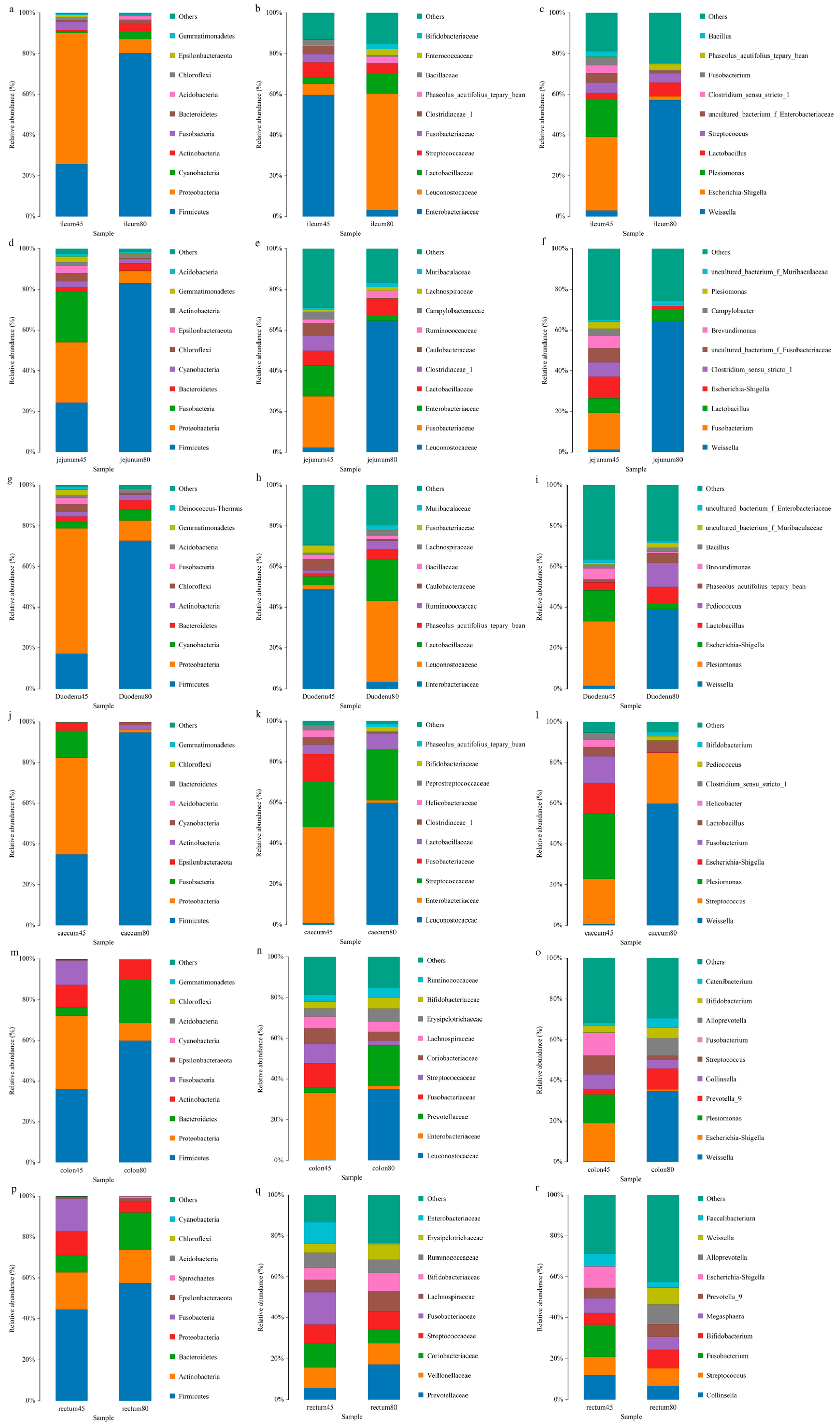




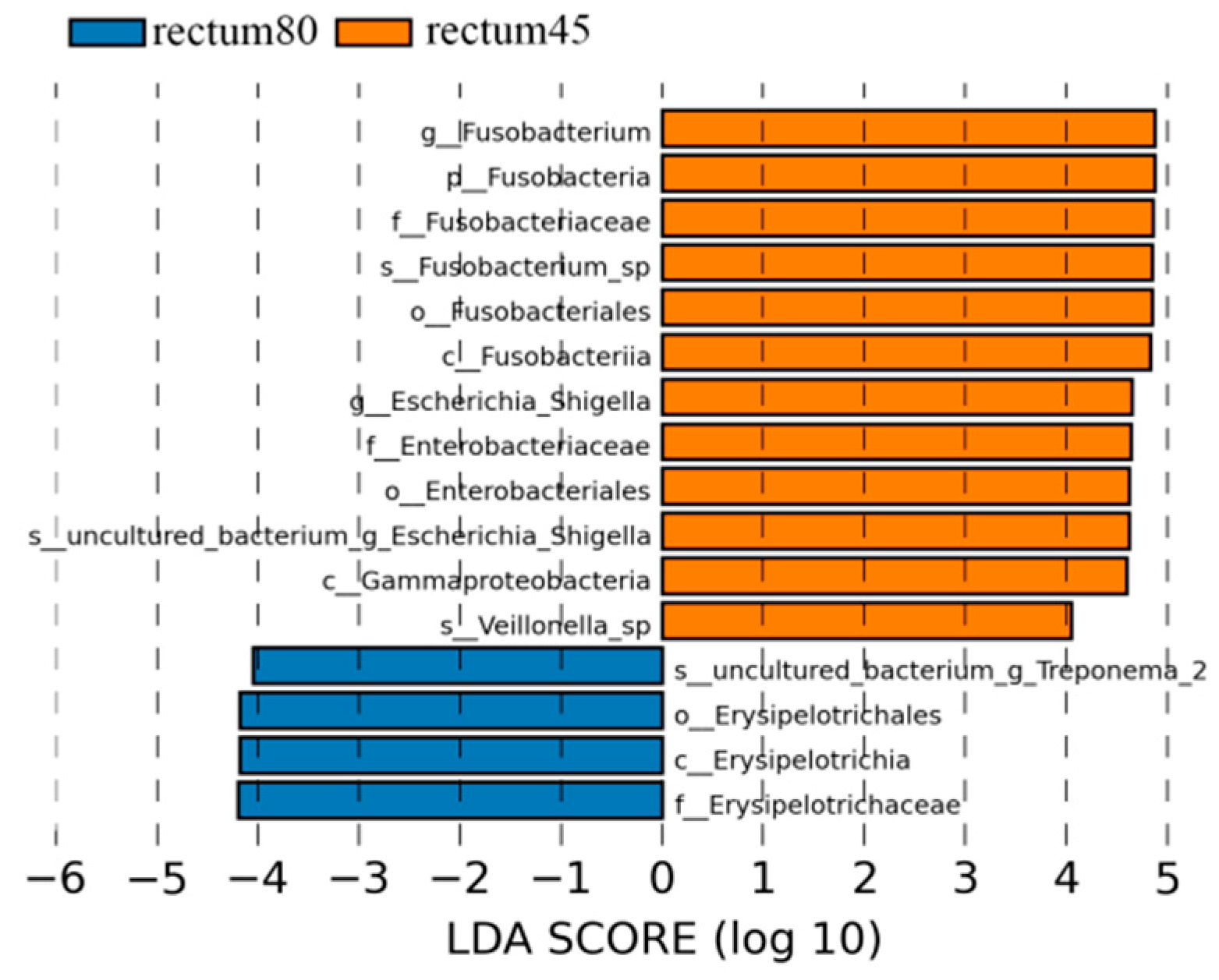
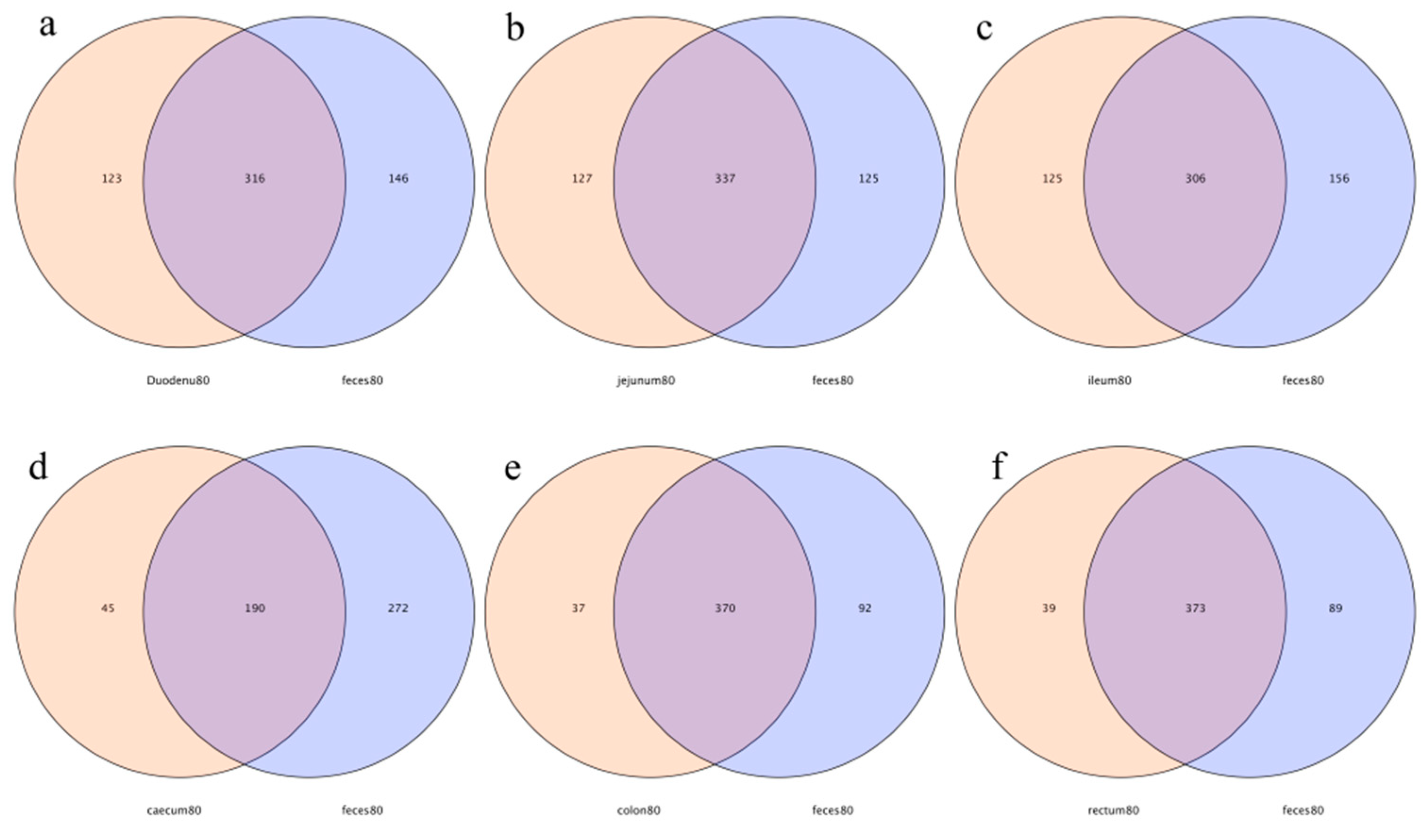
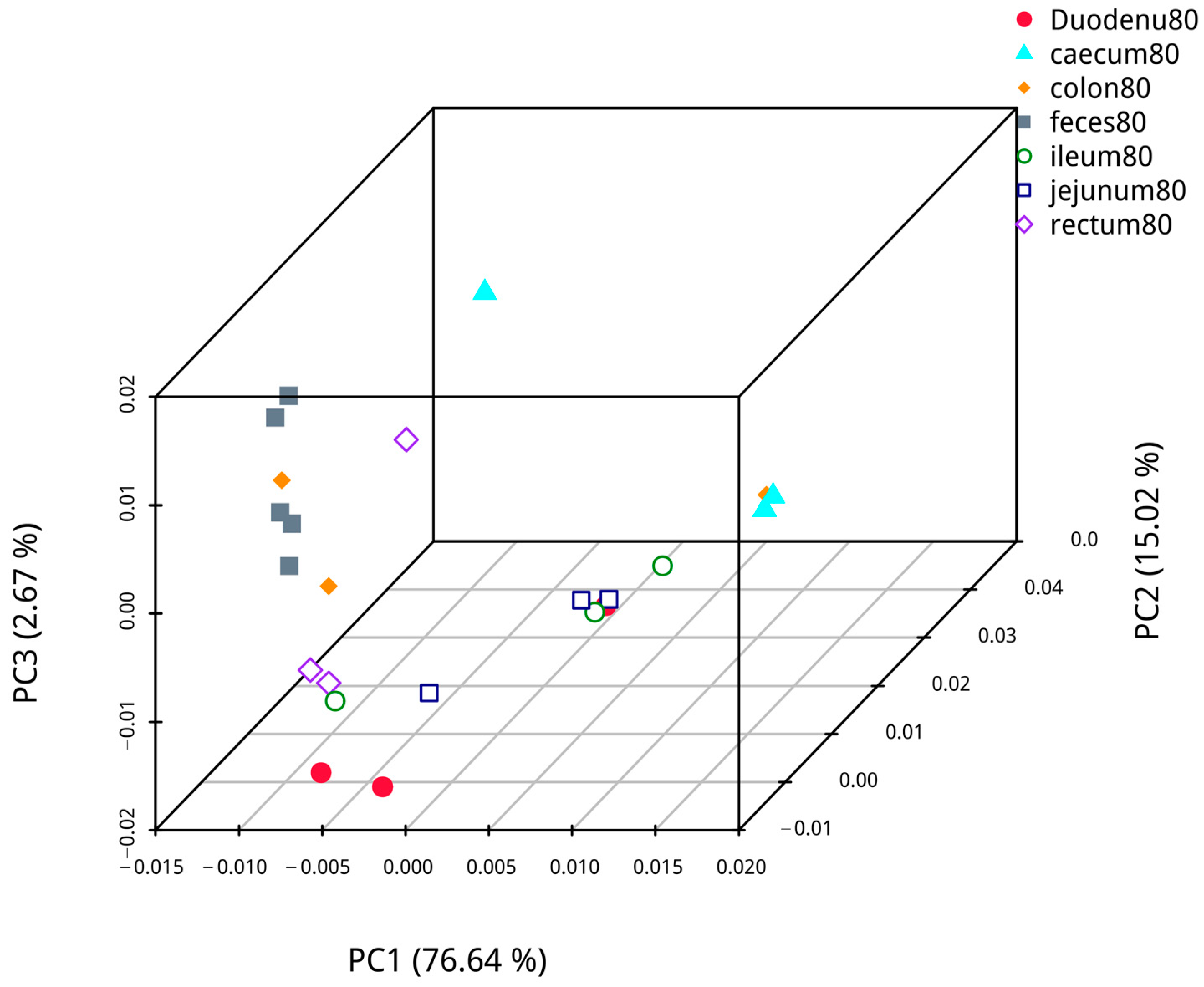
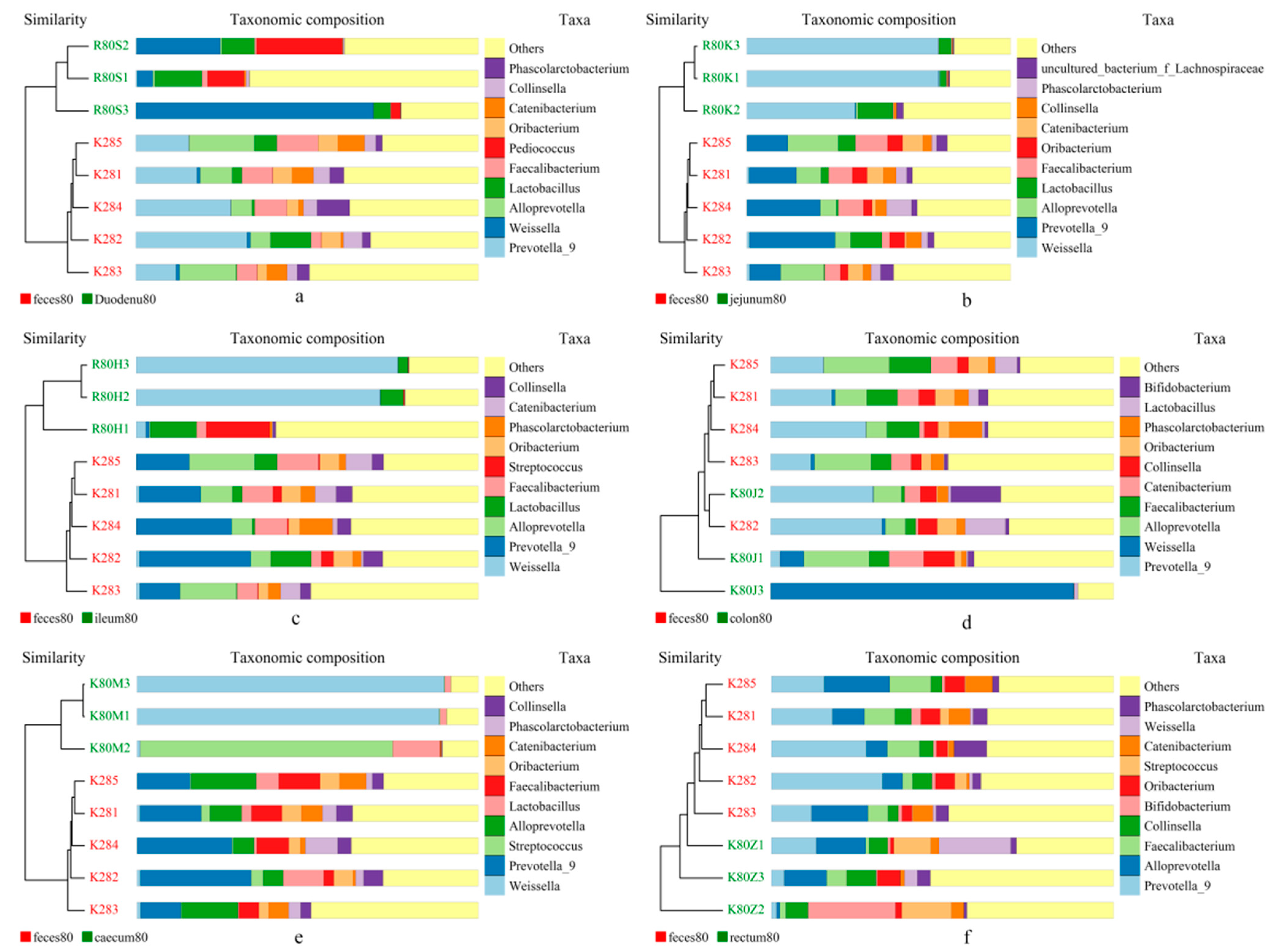
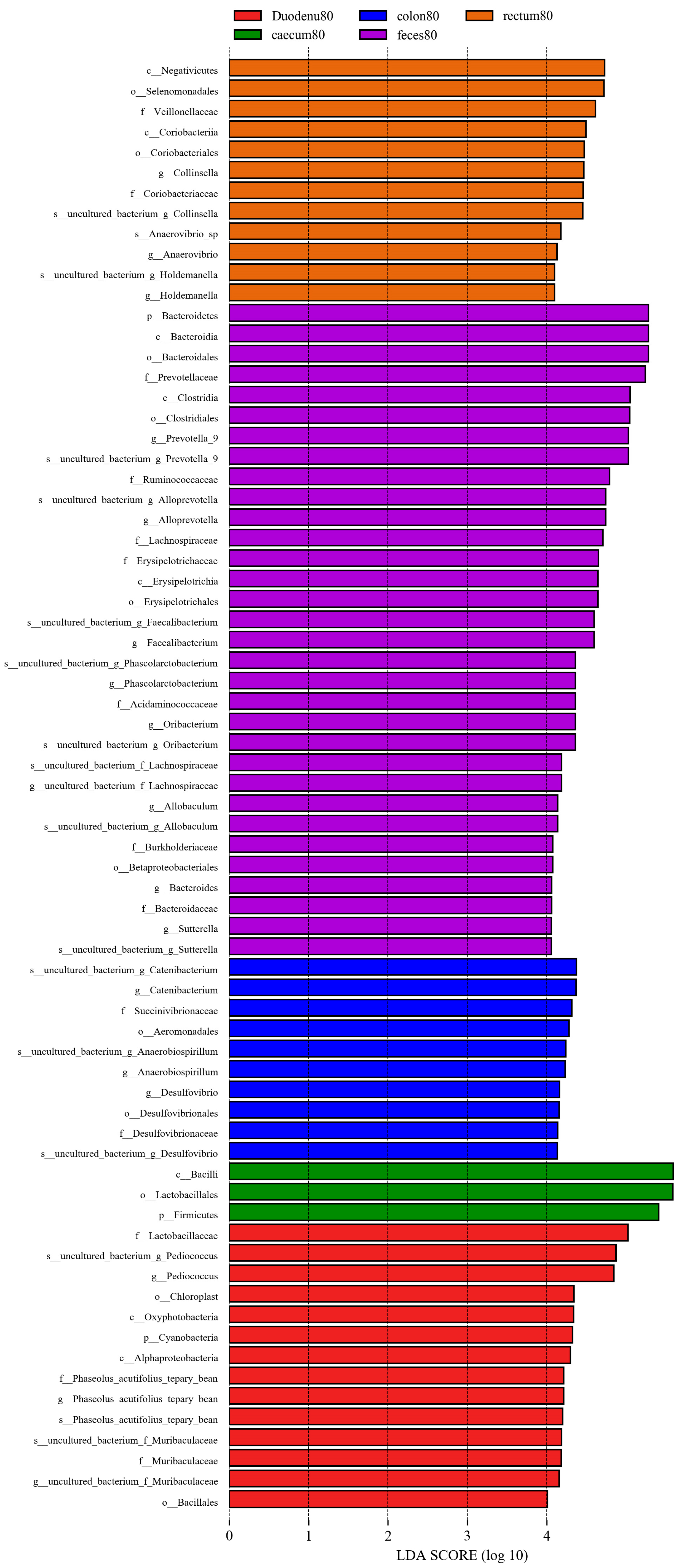
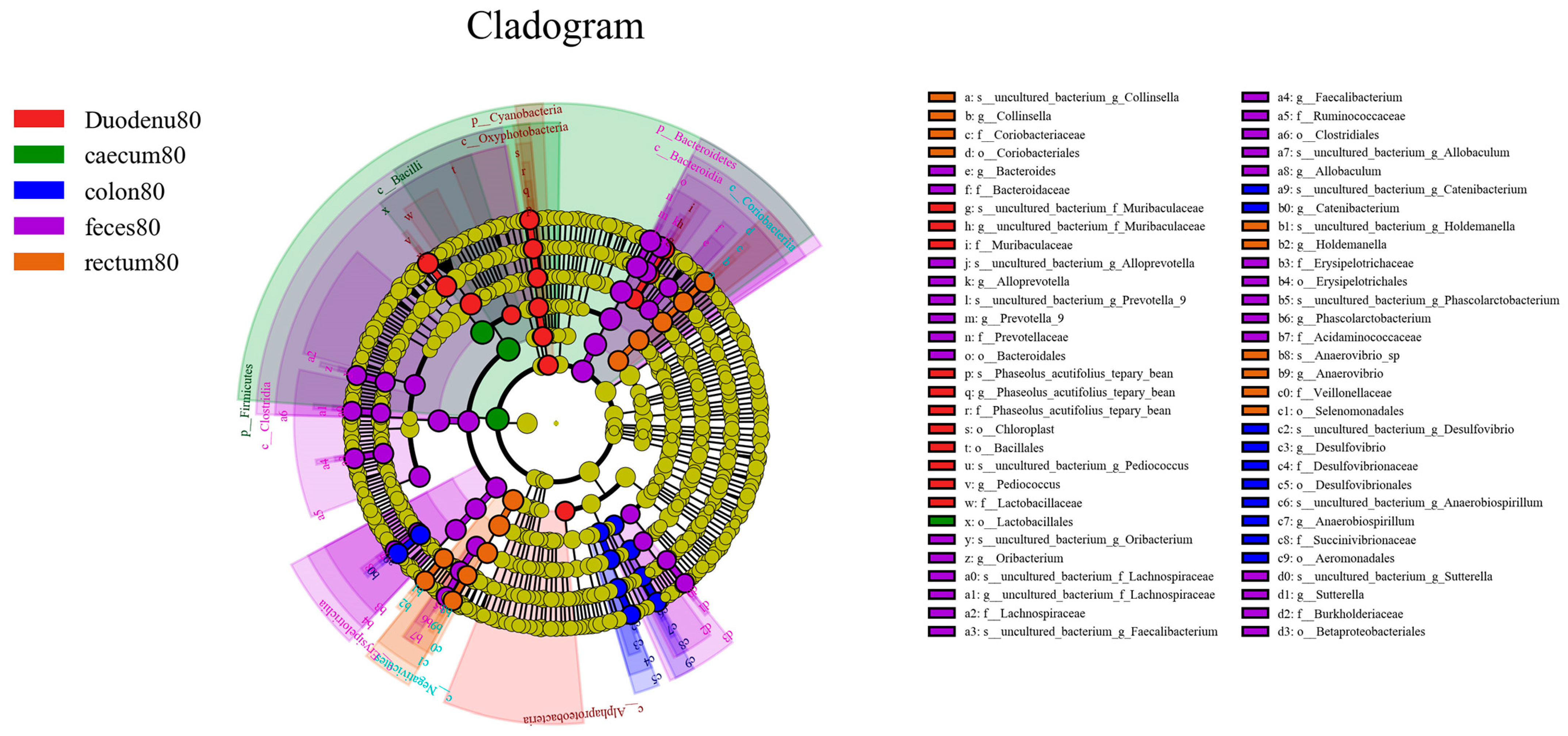
| Items | ACE Index | Chao1 Index | Simpson Index | Shannon Index | |
|---|---|---|---|---|---|
| Duodenum | 45 d | 341.32 ± 14.79 | 343.53 ± 13.37 | 0.81 ± 0.26 | 4.77 ± 2.51 |
| 80 d | 364.47 ± 33.69 | 373.41 ± 36.32 | 0.79 ± 0.24 | 4.79 ± 2.12 | |
| Jejunum | 45 d | 323.84 ± 46.86 | 324.25 ± 47.27 | 0.90 ± 0.09 | 5.00 ± 1.79 |
| 80 d | 383.55 ± 41.35 | 390.21 ± 52.82 | 0.59 ± 0.20 | 3.37 ± 1.34 | |
| Ileum | 45 d | 327.17 ± 15.00 | 331.82 ± 15.96 | 0.74 ± 0.16 | 3.21 ± 1.60 |
| 80 d | 354.07 ± 30.32 | 367.79 ± 47.15 | 0.61 ± 0.29 | 3.46 ± 2.26 | |
| Cecum | 45 d | 283.00 ± 7.48 a | 286.53 ± 7.42 A | 0.64 ± 0.15 | 2.28 ± 1.02 |
| 80 d | 206.04 ± 30.87 b | 183.06 ± 10.59 B | 0.28 ± 0.14 | 1.19 ± 0.50 | |
| Colon | 45 d | 371.03 ± 34.30 | 369.20 ± 28.98 | 0.84 ± 0.13 | 3.99 ± 1.67 |
| 80 d | 314.35 ± 52.45 | 323.38 ± 48.91 | 0.69 ± 0.41 | 3.69 ± 2.37 | |
| Rectum | 45 d | 441.77 ± 25.44 a | 452.93 ± 32.70 | 0.85 ± 0.11 | 4.17 ± 0.99 |
| 80 d | 348.79 ± 34.39 b | 360.60 ± 54.82 | 0.93 ± 0.04 | 4.88 ± 0.78 |
| Items | ACE Index | Chao1 Index | Simpson Index | Shannon Index |
|---|---|---|---|---|
| feces | 392.65 ± 11.82 Aab | 406.49 ± 23.06 Aab | 0.93 ± 0.02 | 5.29 ± 0.29 Aab |
| duodenum | 364.47 ± 33.69 Aba | 373.41 ± 36.32 Aba | 0.79 ± 0.24 | 4.79 ± 2.12 Abab |
| jejunum | 383.55 ± 41.35 Abab | 390.21 ± 52.82 Abab | 0.59 ± 0.20 | 3.37 ± 1.34 Abab |
| ileum | 354.07 ± 30.32 Aba | 367.79 ± 47.15 Abab | 0.61 ± 0.29 | 3.46 ± 2.26 Abab |
| cecum | 206.04 ± 30.87 Bb | 183.06 ± 10.59 Bb | 0.28 ± 0.14 | 1.19 ± 0.50 Bb |
| colon | 314.35 ± 52.45 Abab | 323.38 ± 48.91 Abab | 0.69 ± 0.41 | 3.69 ± 2.37 Abab |
| rectum | 348.79 ± 34.39 Abab | 360.60 ± 54.82 Abab | 0.93 ± 0.04 | 4.88 ± 0.78 Aba |
| Items | R-Value | p-Value |
|---|---|---|
| Duodenum | 1.000 | 0.017 |
| Jejunum | 1.000 | 0.018 |
| Ileum | 1.000 | 0.015 |
| Cecum | 1.000 | 0.020 |
| Colon | 0.744 | 0.018 |
| Rectum | 0.713 | 0.017 |
Disclaimer/Publisher’s Note: The statements, opinions and data contained in all publications are solely those of the individual author(s) and contributor(s) and not of MDPI and/or the editor(s). MDPI and/or the editor(s) disclaim responsibility for any injury to people or property resulting from any ideas, methods, instructions or products referred to in the content. |
© 2024 by the authors. Licensee MDPI, Basel, Switzerland. This article is an open access article distributed under the terms and conditions of the Creative Commons Attribution (CC BY) license (https://creativecommons.org/licenses/by/4.0/).
Share and Cite
Su, H.; Jiang, X.; Liu, H.; Bai, H.; Bai, X.; Xu, Y.; Du, Z. Comparison of Intestinal Microbiota of Blue Fox before and after Weaning. Animals 2024, 14, 210. https://doi.org/10.3390/ani14020210
Su H, Jiang X, Liu H, Bai H, Bai X, Xu Y, Du Z. Comparison of Intestinal Microbiota of Blue Fox before and after Weaning. Animals. 2024; 14(2):210. https://doi.org/10.3390/ani14020210
Chicago/Turabian StyleSu, Hang, Xinshuai Jiang, Hanyu Liu, Huixin Bai, Xiujuan Bai, Yuan Xu, and Zhiheng Du. 2024. "Comparison of Intestinal Microbiota of Blue Fox before and after Weaning" Animals 14, no. 2: 210. https://doi.org/10.3390/ani14020210
APA StyleSu, H., Jiang, X., Liu, H., Bai, H., Bai, X., Xu, Y., & Du, Z. (2024). Comparison of Intestinal Microbiota of Blue Fox before and after Weaning. Animals, 14(2), 210. https://doi.org/10.3390/ani14020210





